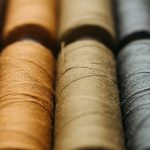You encounter polypropylene fabric every day in activewear that wicks moisture and resists odors, plus outdoor gear like lightweight backpacks and tents. It’s common in upholstery, offering stain resistance and durability, and in home furnishings like rugs and curtains. You’ll also find it in food packaging, automotive parts, and medical items like masks and gowns. Polypropylene’s versatility spans agriculture and industry, making it essential in many products—keep exploring to understand its full range of uses.
Table of Contents
Key Takeaways
- Activewear and outdoor clothing use polypropylene fabric for moisture-wicking, lightweight, odor-resistant properties.
- Upholstery items like stain-resistant furniture covers, rugs, and curtains are commonly made from polypropylene.
- Food packaging materials, including rigid containers and microwave-safe trays, utilize polypropylene for durability and moisture resistance.
- Agricultural products like crop covers, weed control mats, and shade nets are manufactured from polypropylene fabric.
- Automotive interior components such as seat covers, door panels, and insulation frequently incorporate polypropylene for durability and light weight.
Polypropylene Fabric in Apparel
Although you mightn’t always notice it, polypropylene fabric plays an essential role in apparel, especially in activewear and outdoor clothing.
Polypropylene fabric quietly powers your activewear, enhancing comfort and performance in every move you make.
You’ll find it in base layers, socks, and sportswear because it wicks moisture away from your skin, helping you stay dry and comfortable during workouts or hikes.
It’s lightweight and breathable, so you won’t feel weighed down or overheated. Plus, polypropylene resists odors, meaning your clothes stay fresher longer even after intense activity.
You’ll also appreciate its quick-drying properties, making it ideal for travel or unpredictable weather.
When you choose garments with polypropylene, you’re investing in durability and performance, which makes your active lifestyle easier and more enjoyable.
Use of Polypropylene in Upholstery
When you choose polypropylene for upholstery, you get durability and resistance that stand up to daily wear.
You’ll also appreciate how comfortable and flexible the fabric feels, making your furniture inviting.
Plus, cleaning is a breeze, so maintenance won’t slow you down.
Durability and Resistance
Polypropylene stands out in upholstery for its impressive durability and resistance to wear. When you choose polypropylene fabric for your furniture, you get a material that can handle daily use without easily showing signs of damage.
It resists abrasion, so your chairs and sofas maintain their look even after frequent contact. Polypropylene also fights off stains and moisture, making cleanup straightforward and preventing long-term damage. This resistance means your upholstery stays fresh and intact longer, saving you replacement costs.
Plus, it withstands exposure to sunlight without fading, so pieces near windows keep their vibrant colors. By opting for polypropylene, you guarantee your upholstered items are tough enough to meet your lifestyle’s demands, providing lasting quality without compromise.
Comfort and Flexibility
Even though durability is essential, you’ll appreciate how polypropylene fabric also delivers excellent comfort and flexibility in upholstery. Its lightweight nature allows furniture to remain comfortable without sacrificing strength. The fabric’s ability to stretch slightly under pressure means cushions conform to your body, enhancing relaxation. Plus, polypropylene resists moisture and stains, keeping your furniture feeling fresh and soft over time.
Here’s a quick look at how polypropylene fabric benefits upholstery:
| Comfort Aspect | Polypropylene Feature |
|---|---|
| Softness | Smooth texture for coziness |
| Flexibility | Stretches to adapt to pressure |
| Breathability | Allows air circulation |
| Lightweight | Enhances ease of movement |
You’ll find this fabric balances comfort and practicality perfectly in your home furnishings.
Maintenance and Cleaning
Because polypropylene resists stains and moisture, maintaining your upholstery is straightforward and hassle-free. You can easily wipe away spills with a damp cloth before they set.
For deeper cleaning, mild soap and warm water work perfectly without damaging the fabric. Avoid harsh chemicals or bleach, as they can degrade the material over time.
Polypropylene’s quick-drying nature means your furniture won’t stay wet long, reducing the risk of mold or mildew. Regular vacuuming helps keep dust and dirt from settling into the fibers, preserving the fabric’s appearance.
With these simple steps, your polypropylene upholstery stays fresh and durable, saving you time and effort in upkeep while keeping your furniture looking great.
Polypropylene in Packaging Materials
You’ll find polypropylene plays a key role in durable food packaging that keeps items fresh and safe.
It also serves as a lightweight protective wrap, making shipping and handling easier.
Let’s explore how these qualities make polypropylene a top choice in packaging materials.
Durable Food Packaging
Polypropylene plays an essential role in durable food packaging by offering strength, flexibility, and resistance to moisture and chemicals.
When you choose food packaging made from polypropylene, you get reliable protection that keeps products fresh and safe during storage and transportation. This material’s durability helps prevent contamination and spoilage, ensuring the food reaches you in excellent condition.
You’ll often find polypropylene used in:
- Rigid containers for dairy products and deli items
- Clear, resealable bags for snacks and baked goods
- Microwave-safe trays and films for ready-to-eat meals
Lightweight Protective Wraps
When you need lightweight protective wraps that guard your products without adding bulk, polypropylene delivers exceptional performance.
You’ll find polypropylene wraps used to protect fragile items during shipping, as they provide a strong barrier against dust, moisture, and abrasion. Since polypropylene is moisture-resistant and tear-proof, it keeps your goods safe without weighing them down or increasing shipping costs.
These wraps also resist chemicals and UV damage, making them ideal for both short-term and long-term storage. Whether you’re wrapping electronics, glassware, or textiles, polypropylene wraps offer reliable cushioning and protection.
Plus, they’re easy to handle and recycle, so you can safeguard your products while minimizing environmental impact. Choosing polypropylene wraps means you get durable, lightweight protection every time.
Industrial Applications of Polypropylene Fabric
Because of its durability and resistance to chemicals, polypropylene fabric plays an essential role in various industrial applications.
When you work in industries requiring strong, lightweight materials, this fabric proves invaluable. You’ll find it in situations demanding chemical resistance, moisture-wicking, and abrasion protection.
Here are some common uses:
- Geotextiles: Stabilizing soil and preventing erosion on construction sites.
- Industrial packaging: Creating durable bags and covers that protect goods during shipping.
- Filter fabrics: Used in air and liquid filtration systems due to its chemical inertness and fine weave.
Polypropylene in Medical Textiles
Although medical environments demand strict hygiene and safety standards, you’ll find polypropylene fabric widely used due to its excellent barrier properties and lightweight feel.
When you wear disposable gowns, masks, or surgical caps, polypropylene’s moisture resistance helps keep contaminants away, protecting both patients and healthcare workers.
You’ll also encounter this fabric in wound dressings and sterilization wraps, where its breathability supports healing while maintaining a sterile barrier.
Plus, polypropylene is easy to produce and cost-effective, making it ideal for single-use medical items that require high cleanliness levels.
Sports and Outdoor Gear Made From Polypropylene
Polypropylene’s moisture resistance and lightweight nature don’t just serve medical needs—they also make it a favorite in sports and outdoor gear.
Polypropylene’s moisture resistance and light weight make it ideal for durable, comfortable sports and outdoor gear.
When you’re out on a hike or hitting the gym, polypropylene keeps you comfortable by wicking sweat away and drying quickly. Its durability means your gear withstands rough use without adding extra weight.
Here are some common sports and outdoor items made from polypropylene:
- Performance base layers and thermal underwear that keep you warm and dry
- Lightweight backpacks and duffel bags designed for rugged adventures
- Durable outdoor tents and tarps offering water resistance and easy packing
Polypropylene in Home Furnishings
Durability and ease of care make polypropylene a popular choice in home furnishings. When you pick polypropylene fabric for your upholstery, you’re choosing something resistant to stains and fading, perfect for busy households.
It’s also lightweight, so you can easily move around chairs or cushions covered in this material. Polypropylene rugs are another great option—they’re durable, easy to clean, and hold up well against spills or heavy foot traffic.
If you want low-maintenance curtains or slipcovers, polypropylene’s moisture-resistant nature means they dry quickly and resist mildew.
Using polypropylene, you’ll find your home furnishings stay looking fresh and vibrant longer, without demanding extra effort from you. It’s a practical, cost-effective fabric that blends comfort with resilience.
Agricultural Uses of Polypropylene Fabric
Farmers and gardeners rely on polypropylene fabric for a wide range of applications that help protect crops and improve yield. You’ll find it essential in shielding plants from harsh weather and pests, ensuring healthier growth.
Here’s how polypropylene fabric supports your agricultural efforts:
- Crop covers and row covers: These lightweight fabrics create a barrier against frost, insects, and birds without blocking sunlight or airflow.
- Weed control mats: Placing polypropylene mats under plants reduces weed growth, saving you time and reducing chemical use.
- Shade nets: These fabrics provide adjustable shade, protecting delicate crops from excessive sun and heat stress.
Using polypropylene fabric in these ways helps you maintain healthier crops, boost productivity, and reduce reliance on chemical interventions, making your agricultural practices more sustainable and efficient.
Polypropylene in Automotive Components
When you look inside a car, you’ll notice many parts made from polypropylene fabric and materials because they offer a perfect balance of strength and flexibility.
Inside cars, polypropylene materials provide an ideal mix of strength and flexibility for various parts.
You’ll find polypropylene used in seat covers, door panels, and even insulation materials. It resists wear and tear, making your car’s interior durable and long-lasting.
The fabric’s lightweight nature also helps improve fuel efficiency by reducing overall vehicle weight. Plus, polypropylene doesn’t absorb moisture, so it protects your car’s interior from mold and mildew.
You’ll also see it in airbags and under-the-hood components, where heat resistance and toughness are essential.
Frequently Asked Questions
Is Polypropylene Fabric Biodegradable or Recyclable?
You’ll find polypropylene fabric isn’t biodegradable, so it won’t break down naturally. However, you can recycle it where facilities exist, helping reduce waste and supporting environmental sustainability efforts. Just check local recycling options first.
How Does Polypropylene Fabric React to High Temperatures?
You’ll find polypropylene fabric melts at around 160°C (320°F) and can deform under high heat. So, you shouldn’t expose it to open flames or hot surfaces, or it’ll lose its shape and strength quickly.
Can Polypropylene Fabric Cause Allergic Skin Reactions?
You typically won’t have allergic skin reactions from polypropylene fabric since it’s hypoallergenic and moisture-wicking. However, if you have sensitive skin or allergies to synthetic materials, you might experience irritation or discomfort occasionally.
What Are the Environmental Impacts of Polypropylene Production?
Like the hidden cost of a fast fashion spree, polypropylene production emits greenhouse gases and relies on fossil fuels. You’ll find it contributes to pollution and waste, urging you to contemplate more sustainable choices.
How Does Polypropylene Compare to Polyester in Durability?
You’ll find polypropylene is more resistant to moisture and chemicals, while polyester offers better UV resistance and strength. Both are durable, but your choice depends on whether you prioritize water repellency or overall toughness.
- Where to Buy Sherpa Suede Fabric - July 12, 2025
- How to Draw or Illustrate the Texture of Suede Fabric - July 12, 2025
- What Is Baseball Suede Leather Fabric? - July 12, 2025







